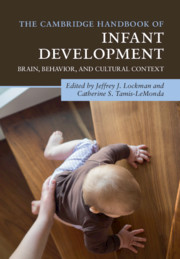Book contents
- The Cambridge Handbook of Infant Development
- The Cambridge Handbook of Infant Development
- Copyright page
- Dedication
- Contents
- Illustrations
- Contributors
- Preface
- Part I Foundations
- Part II Perceptual Development
- Part III Cognitive Development
- Part IV Action
- Part V Language
- 21 Infant Speech Perception
- 22 Infant Vocal Learning and Speech Production
- 23 Infant Word Learning and Emerging Syntax
- 24 Dual Language Exposure and Early Learning
- Part VI Emotional and Social Development
- Index
- References
23 - Infant Word Learning and Emerging Syntax
from Part V - Language
Published online by Cambridge University Press: 26 September 2020
- The Cambridge Handbook of Infant Development
- The Cambridge Handbook of Infant Development
- Copyright page
- Dedication
- Contents
- Illustrations
- Contributors
- Preface
- Part I Foundations
- Part II Perceptual Development
- Part III Cognitive Development
- Part IV Action
- Part V Language
- 21 Infant Speech Perception
- 22 Infant Vocal Learning and Speech Production
- 23 Infant Word Learning and Emerging Syntax
- 24 Dual Language Exposure and Early Learning
- Part VI Emotional and Social Development
- Index
- References
Summary
For centuries philosophers and scientists have puzzled over the meaning of words and the intricacies of grammar. How did the human species develop such a complex system that allowed us to work collaboratively and to share experiences – be it about the past or future? How did the species derive a system that allowed for optimal representation of the world in a way that also optimized quick communication among members of the species? Our language can mend conflicts, share grand ideas, and allow us to express and grow our everyday thoughts.
Keywords
- Type
- Chapter
- Information
- The Cambridge Handbook of Infant DevelopmentBrain, Behavior, and Cultural Context, pp. 632 - 660Publisher: Cambridge University PressPrint publication year: 2020

